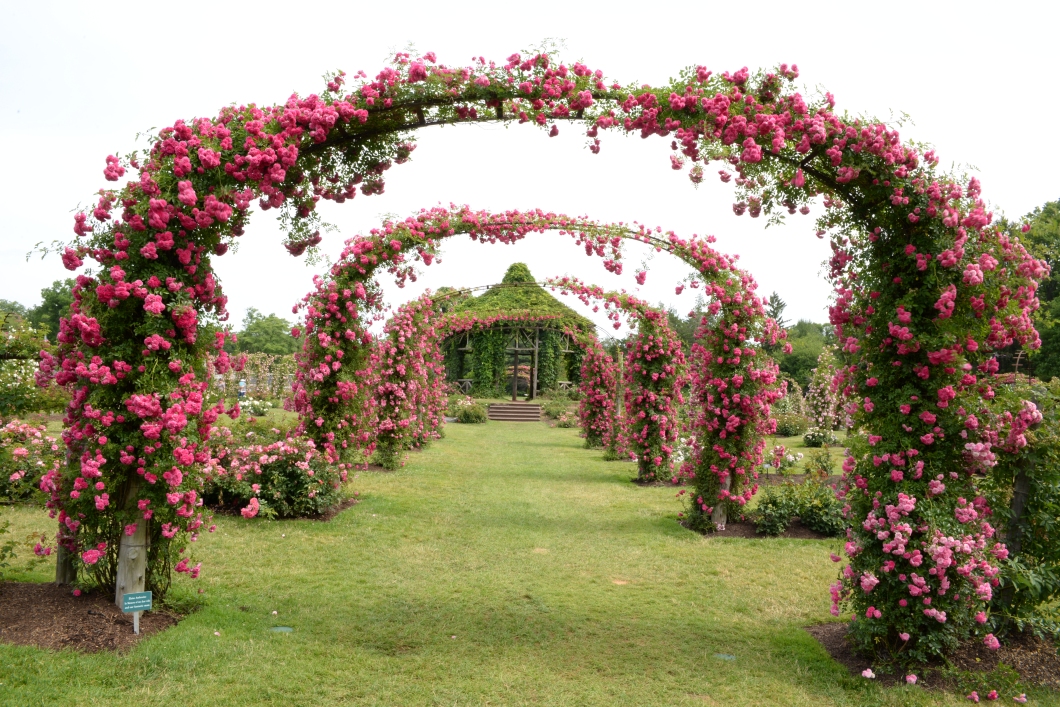by Peter Winne
It’s late June, which means the arches are in full bloom at Elizabeth Park. Endless clusters of delicate white, pink, and red blossoms cascade over pathways framed by arched trellises. Every year starting around the summer solstice and lasting through the 4th of July these ramblers all but eclipse the park’s other roses, forming the backdrop for countless wedding photos and Instagram posts (see some of the best ones below).

Elizabeth Park is home to the largest display of arched trellises in the U.S.; on them we grow four varieties of ramblers: Excelsa, Crimson Rambler, White Dorothy, and the subject of this post, Dorothy Perkins. Dorothy Perkins was named for the granddaughter of Charles Perkins, founder of American plant wholesaler Jackson & Perkins (Scanniello, 1994, p. 89). Charles started the business in 1872 to sell strawberry and grape plants; his foreman, E. Alvin Miller, happened to dabble in hybridizing roses, prompting the company to market one of his successes as “Dorothy Perkins” in 1901 (Jackson & Perkins, 2018).
Noted for its abundant light pink blossoms, Dorothy Perkins was the first rambler hybrid to truly thrive in northern climates (Scanniello, 1994, p. 89). From the time of its introduction until a nationwide move toward repeat-blooming climbers in the 1930s, Dorothy Perkins was the best-selling climbing rose in the United States (Scanniello, 1994, p. 89). In response to Dorothy’s success, Jackson & Perkins began focusing exclusively on roses (Jackson & Perkins, 2018), becoming one of the largest rose retailers in the world.

And as for White Dorothy—this white-blossomed counterpart is a “sport,” or naturally occurring genetic mutation, of Dorothy Perkins, discovered in 1908 by English nursery Benjamin R. Cant & Sons (Dobson & Schneider, 2018). We grow both varieties at Elizabeth Park.

Last year the Dorothy Perkins at Elizabeth Park produced a second, smaller bloom in early August. She also attracted aphids and a fair amount of powdery mildew, though neither inflicted any lasting damage. Once every few summers we untie the plants from the arches for a heavy pruning, and every December we cover them with evergreen boughs to protect against winter damage.




Sources:
Dobson, B.R. & Schneider, P. (2018). Combined Rose List 2018. Mantua, OH: The International Rose Directory.
Jackson & Perkins (2018). About us. Retrieved June 29, 2018, from https://www.jacksonandperkins.com/about-jackson-and-perkins/a/500/
Scanniello, S. (1994). Climbing Roses. Upper Saddle River, NJ: Prentice Hall
Hi Peter –
What a lovely blog and such beautiful photos! Jackson & Perkins is proud to continue to be one of the leading rose providers. To this day, the ‘Dorothy Perkins’ Rose is one of the most-know climbing roses. It is truly beautiful!
You can shop with us online any time at http://www.jacksonandperkins.com
LikeLike
So glad this post made it your way and that you reached out. Thanks for the compliments and for over a century of wonderful roses!
Pete
LikeLike
[…] lawn games are back in the attic. Here at Elizabeth Park the dog days mean rambler pruning. In my last post I wrote about the Park’s famous arched trellises. Every July, soon after their blossoms […]
LikeLike
[…] far I’ve devoted this blog to beautiful things in the garden, such as heritage roses and trellised arches covered in rambling blossoms. Today, however, we take a turn for the ugly to discuss a particularly virulent rose disease called […]
LikeLike
[…] June, with its blooming arches and brilliant first flush of blossoms may draw the biggest crowds, but park regulars know the rose […]
LikeLike